How to Whiten a White Folder Again
Windows contains plenty of files and folders that you don't really need. Between hidden caches, erstwhile junk that wastes space, and files you can actually delete to solve issues, knowing what's safe to remove from Windows can be challenging.
Permit's pace through some Windows files and folders that are totally safety to remove, along with why you might desire to erase them. This volition aid you lot gratis up disk space and learn more than nigh your PC. Annotation that some of these folders are in organisation-protected locations, so take care when deleting them.
The All-time Way to Clean Windows Folders: Disk Cleanup or Storage Sense
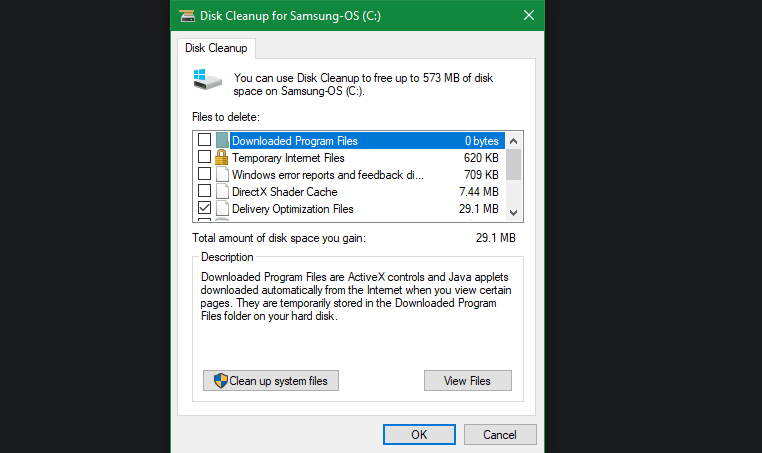
Earlier we look at Windows files and folders you tin safely remove, you lot should know that manually deleting them isn't commonly the best fashion to go near it.
Bated from wasting time doing this yourself when you could automate the procedure, it's safer to let the Disk Cleanup tool do these cleanings for yous. This avoids accidentally deleting files that you lot need or messing with the wrong folders.
The Windows Deejay Cleanup tool helps you reclaim disk space on your computer and is simple to use. You can open up it by searching for Deejay Cleanup in the Start carte and selecting a drive. Permit it scan, and yous'll meet several categories of files you tin erase. For more than options, choose Clean upwardly organisation files and provide administrator permissions.
If you find this interface too clunky, you can browse to Settings > System > Storage to endeavor the newer storage cleanup tool in Windows 10 and 11. Click Temporary files in the list of options, and then you'll see a list populate that'south like to what Disk Cleanup offers.
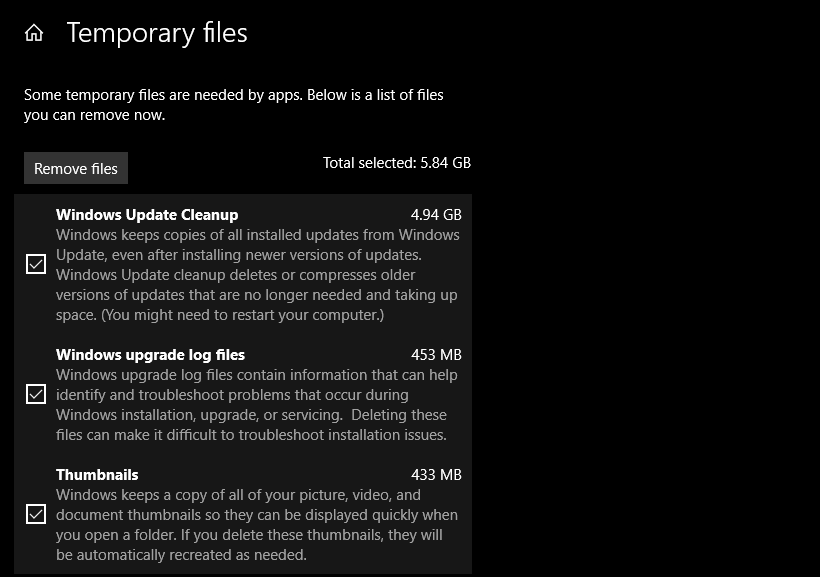
What to Delete From Disk Cleanup
This isn't a total guide to the Disk Cleanup tool, so nosotros're non going to await at every entry in the menu. Nevertheless, the post-obit options are low-hanging fruit (make certain to select Clean upwardly system files first to see them all):
- Windows Update Cleanup: This erases old copies of Windows Update files. These are safe to delete in most cases, only if you run into update-related issues, you should keep them for troubleshooting.
- Windows upgrade log files: Similarly to the higher up, these are data files that Windows Update stores to assistance you dig into problems concerning upgrades or installations. You lot can erase these if y'all haven't had errors related to upgrading Windows to a new version.
- Linguistic communication resource files: If you've previously downloaded another language or keyboard layout that yous don't use, this will allow you hands erase it.
- Recycle Bin: While yous tin empty the Recycle Bin through its own window, you lot tin also practice it easily here. Merely make sure there's zip inside it that y'all demand.
- Temporary files: As their name suggests, temporary files aren't used for annihilation in the long term, so you can erase them without worry.
Now, allow's look at what you tin can delete from Windows 10 and Windows 11 safely. Usually, these files are on your C: drive, but you lot might find them elsewhere if yous take multiple storage disks and have installed Windows with custom options.
1. The Hibernation File
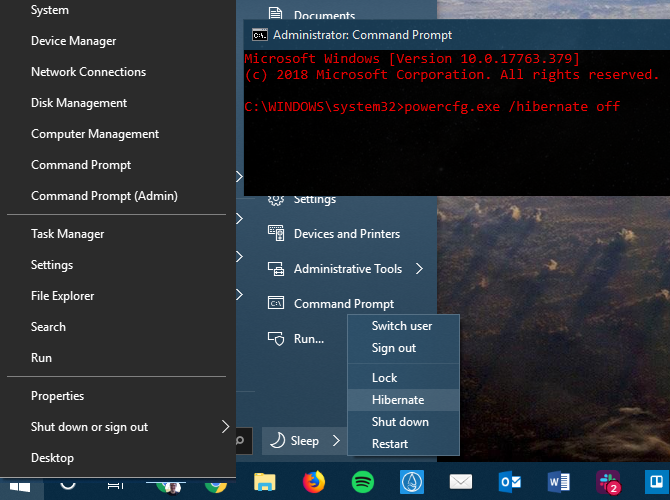
Location: C:\hiberfil.sys
Hibernation fashion on your PC is a bit similar sleep manner, except the system saves all your open work to the storage drive and and then shuts down. You can remove the bombardment from your laptop and stay in hibernation for a week, then start support and pick upwards right where you left off.
Of class, this takes up space, which is what the hibernation file is for. Depending on your difficult drive size, the hibernation file is likely several gigabytes or more.
If y'all don't utilize hibernation and want to disable information technology, you can hands do so via the command line. Annotation that you shouldn't just delete hiberfil.sys, as Windows will recreate it again.
Instead, correct-click on the Outset button or press Win + X, then open a Command Prompt (Admin), Windows PowerShell (Admin), or Windows Terminal (Admin) window from the resulting menu. Type the following control to disable hibernation:
powercfg.exe /hibernate off That's all it takes to disable hibernation. Windows should delete hiberfil.sys on its own when y'all practice this; feel free to delete it after if not. Annotation that disabling hibernate mode will besides forbid your computer from using fast startup in Windows 10 and 11. However, this isn't much of a loss, as this characteristic is known to crusade ho-hum Windows kick times and other issues.
2. Windows Temp Folder
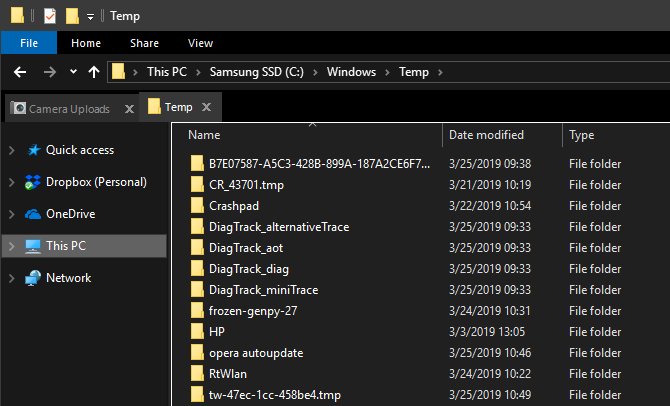
Location: C:\Windows\Temp
As you lot'd guess from the name, Windows temporary files aren't important beyond their initial use. The files and folders inside incorporate info that Windows used at once, merely doesn't need anymore.
Instead of cleaning via Disk Cleanup. yous tin can visit this folder and delete its contents manually, if you want. But press Ctrl + A to select everything inside, then hit Delete. Windows might requite y'all an error about a couple of items when you practice this—just ignore those and clear everything else.
This folder volition fill with new items over fourth dimension, which is a normal part of Windows' performance.
3. The Recycle Bin
Location: beat:RecycleBinFolder
The Recycle Bin is a special folder—while it appears nether your C:\ drive, this is protected by Windows and you don't demand to access it that way. Whenever you delete a file on your system, Windows sends it to the Recycle Bin. This is a special place where deleted files are kept until you permanently delete or restore them.
While this might be obvious to you, we're including it in example some aren't aware. It's easy to forget that gigabytes of old information can sit in your Recycle Bin.
You can access the Recycle Bin through the shortcut on your desktop. If you don't see that, type beat out:RecycleBinFolder into File Explorer's navigation bar. In one case here, you lot'll see everything you've deleted recently.
Correct-click on individual items and choose Delete to permanently erase them, or choose Restore to send the file back to its original location. On the top Ribbon'due south Recycle Bin Tools tab, you'll run across buttons to Empty Recycle Bin and Restore all items at once.
To tweak the mode the Recycle Bin works, click Recycle Bin properties here. On this menu, you can alter the maximum size of the bin, or fifty-fifty choose Don't movement files to the Recycle Bin.
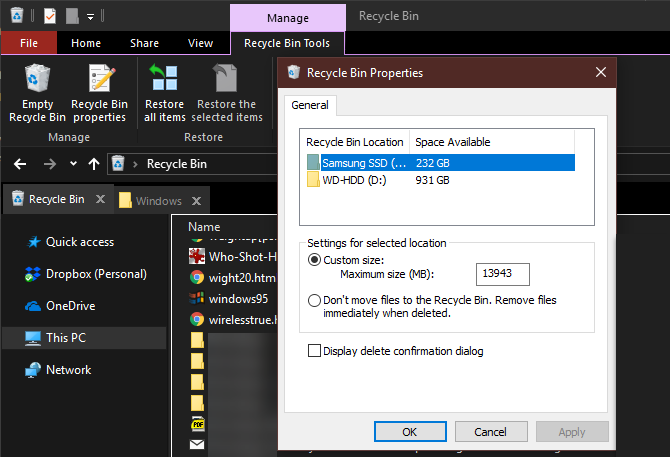
With this choice, Windows skips the bin and permanently removes items when y'all delete them. We don't recommend this, because the Recycle Bin gives you a 2nd chance in case of accidental deletion. Similarly, Display delete confirmation dialog will require an actress pace whenever you erase a file.
4. Windows.old Folder
Location: C:\Windows.onetime
Whenever you upgrade your version of Windows, the system keeps a copy of your prior files, chosen Windows.old. This folder substantially holds everything that fabricated upwards your old installation, in example something didn't transfer correctly.
If necessary, you tin employ this folder to roll back to a previous version of Windows. It'south also possible to open up the folder and grab a few stray files if you need them.
Windows automatically removes this binder a short time subsequently upgrading, only you tin can remove information technology yourself if you're crunched for space. It won't delete if you endeavor to go through File Explorer, and then to erase information technology from your bulldoze properly, type Disk Cleanup into the Offset Menu and launch the tool as described earlier.
Click Clean upwards system files at the bottom of the window and allow the utility practice another scan. Once that'south washed, await for the Previous Windows installation(s) and delete information technology using this tool.
Manifestly, removing these files makes information technology harder to recover information in example of an upshot. After performing a Windows upgrade (even only to the latest version of Windows 10 or xi) we suggest you to concur onto this folder until you lot're certain everything is working properly.
v. Downloaded Program Files
Location: C:\Windows\Downloaded Programme Files
This binder'due south name is a flake disruptive; it doesn't have anything to do with apps you've downloaded. Instead, it holds files used past Internet Explorer's ActiveX controls and Java applets, so if yous utilise the aforementioned characteristic on a website, you don't have to download it twice.
In effect, this folder is useless today. ActiveX is an extremely outdated technology that'south total of security holes, and Java is virtually-extinct on today's web. Internet Explorer is the only browser that supports ActiveX, and you'll probably merely run across it on ancient corporate websites (if ever) now.
Almost nobody uses IE anymore, let alone ActiveX. Thus, your Downloaded Program Files folder might already exist empty, simply feel gratis to clean out the contents if it'south non.
6. LiveKernelReports
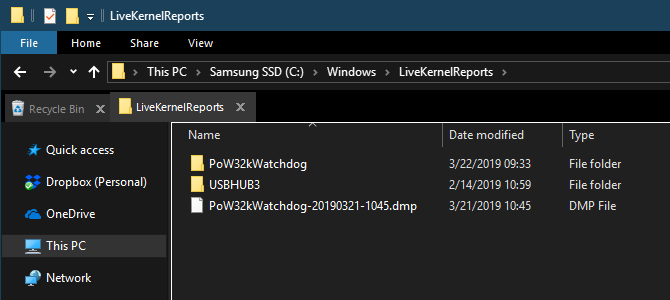
Location: C:\Windows\LiveKernelReports
The LiveKernelReports folder is some other directory that likely comes upwardly when you're scanning for large files on your computer. This binder is home to dump files, which are ongoing information logs that Windows keeps. If your computer runs into an issue, you lot can analyze the contents of these files to beginning troubleshooting your problem.
Whatsoever huge files ending with the DMP file extension in this binder are prophylactic to delete if you don't need to look deeper into them. Like the above locations, though, we recommend using Disk Cleanup instead of deleting the file yourself.
When Windows crashes or you have other major computer problems, don't delete these dump files right away. Yous tin employ a programme like WhoCrashed to get more info from them.
7. Rempl Binder
Location: C:\Program Files\rempl
While the Rempl folder isn't large, you might be surprised when you see it appear on your system. Information technology contains several small files, and you might even notice a few Chore Manager processes connected to it.
This folder is continued to Windows 10 and 11's update delivery. It includes "reliability improvements" to help make Windows updates go smoothly and atomic number 26 out compatibility issues.
And then can yous delete the Rempl binder? There are seemingly no adverse furnishings from doing so. All the same, since it only takes upwardly a few megabytes and can make Windows upgrades less frustrating, information technology's best to keep it around.
The Windows Files You Can Safely Delete
It takes a fleck of looking around to notice them, but Windows holds enough of files and folders that aren't necessary. Recall that your computer does a pretty good job of keeping itself make clean, then yous don't accept to constantly remove the contents of these folders unless you're really low on disk infinite.
Running the Disk Cleanup tool once or twice a calendar month should do enough to keep the cruft away. If you still need to gratis upwards a lot of space, attempt uninstalling some unnecessary Windows software.
Nearly The Author
weberentrught1943.blogspot.com
Source: https://www.makeuseof.com/tag/delete-windows-files-folders/

0 Response to "How to Whiten a White Folder Again"
Post a Comment